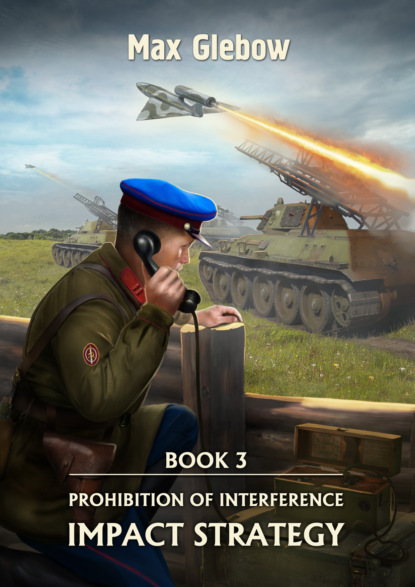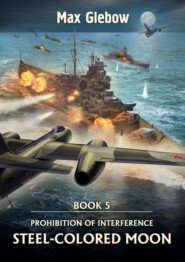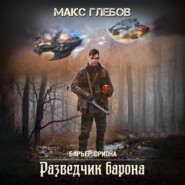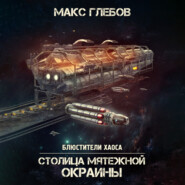По всем вопросам обращайтесь на: info@litportal.ru
(©) 2003-2024.
✖
Prohibition of Interference. Book 3. Impact Strategy
Настройки чтения
Размер шрифта
Высота строк
Поля
This is very promising, but again, too complicated to begin with. Let's keep looking. In addition to airplanes the Germans did not forget about jet projectiles. They developed their six-barreled Nebelwerfer back in the early thirties. It was originally designed to fire smoke and chemical shells, but in the realities of World War II only high-explosive shells were used. Structurally, the German projectiles differed in the way they stabilized in flight, but the Germans did not invent anything particularly breakthrough for this era, and their system was generally inferior to the Russian Katyusha rocket launcher, even though it had a higher shot grouping. For me, the Nebelwerfer is obviously useless. Let's put it aside.
Okay, now the proud British. What are they doing in the jet field? Here we go again with airplanes. The first flight of the Gloster Meteor Mk.1 took place in May 1941. The British have a turbojet engine, but the islanders are clearly far behind the Germans, although in general they follow the same path. Not interesting. Do they have rocket artillery? They have no analogues of Katyushas and Nebelwerfers… О! Anti-aircraft rockets! Unfortunately, they're unguided and outrageously primitive – only suitable for barrage fire. All in all, garbage.
Strange as it may seem, the original development in the field of jet aviation was even found in Italy. Their Caproni Campini N.1, with a strange hybrid of piston and jet engines, even managed to make a successful flight, but this design did not evoke in me anything but a sad smile, and it was even more useless to me than the British anti-aircraft missiles.
Okay, let's leave Europe behind. What's going on overseas? The U.S. Air Force was not interested in jets. In 1939, Lockheed tried to apply to them for funding for research in this area, but was refused. That is where it all came to a standstill. Now, however, the U.S. military seems to be changing their mind, but so far nothing worthwhile has been done. Rocket artillery is also in its infancy, although there is some potential… So, what is this? No one else currently has one of these! The M1 anti-tank grenade launcher, aka bazooka. Shaped grenade with rocket motor, caliber 60 millimeters, effective range 130 meters. The design… Yeah. But it could have been worse. In this form, of course, it would not be suitable for the Red Army and Soviet industry, but that's why I have computers…
My musings were interrupted by the clang of the deadbolt and the creak of the door opening.
“Arrested Nagulin, out!”
* * *
“How is the Nagulin investigation going?” Beria looked tired.
“The testimony was taken from him by four investigators,” Sudoplatov answered clearly. “The questions were formulated in such a way that it was not clear what it was that interested us most. Nagulin gave detailed answers. Immediately after Nagulin's interrogations were completed, we began working with the pilots and navigators of the surviving bombers, as well as with those who survived from the crews of the downed planes. Now their questioning has been completed. We are conducting a detailed analysis. At first glance, Nagulin's testimony does not contradict their words.”
“Are there any preliminary conclusions?”
“That's right,” nodded Sudoplatov, “Nagulin maintains that he did not know about the German night fighters, and began responding to their appearance only after radio reports of an attack on the bombers.”
“How did he find and shoot down the Germans?” Beria squinted slightly under the pince-nez.
“He claims that he flew into the area of enemy fighters, guided by the known current position of the attacked TB-7s and Yer-2s. Well, then his phenomenal night vision came into effect, the exceptional capabilities of which have been confirmed by our physicians. But even these possibilities are not unlimited. That's the reason he couldn't shoot down all the Dorniers. He just couldn't find two of them.”
“How did the Germans know about the operation?”
“Nagulin does not have a definite answer to this question, except for his assurance that he did not inform any outsider about the upcoming flight. Nevertheless, he suggested that the Germans themselves might have come to the conclusion that we could use night bombers near Kiev, because we had demonstrated something similar to them once before during the evacuation of Captain Shcheglov's group.”
Beria stood up in silence and walked around the office.
“Three hours ago I was with the Commander-in-Chief,” said the Commissar softly. “I reported on the operation and the losses.”
At the mention of Stalin Sudoplatov also rose and turned to Beria waiting to continue, but the Commissar remained silent, and Pavel Anatolievich dared to ask the question that had interested him.
“Did you also report Nagulin's arrest, comrade…”
“Not yet,” Beria interrupted him. “And apparently I won't have to.”
“Has something happened?”
Beria silently went to his desk and took from it a sheet of paper with the text printed on it.
“Read this, Pavel Anatolyevich. It came this afternoon through diplomatic channels.”
Sudoplatov read the typewritten text carefully for about a minute, then looked up at Beria in surprise. “Lavrentiy Pavlovich, is this information verified?”
“By now it has been confirmed by other sources.”
“But this is…”
“Yes. You understand correctly. Comrade Stalin personally congratulated me on the success of the operation and asked me to see to it that all its participants be presented with state awards. Six German generals died under the bombs of Nagulin's air group, Colonel General Guderian, the founding father of the German armored forces and the symbol of the lightning war strategy, was among them.”
“Nagulin liquidated the "fast-moving Heinz"?” asked again Sudoplatov, still not fully believing what he had heard.
“That's right, Pavel Anatolyevich, that's right.”
“And now what?”
“Take your subordinate away from the investigators,” Beria shrugged. “Terminate the case for lack of corpus delicti.”
Chapter 5
“Do you also draw?” Lena's right eyebrow went up when she saw me, pencil and ruler in hand, concentrating on drawing something on a piece of paper.
I put my pencil and ruler aside and looked at my girlfriend, who had just woken up. Sudoplatov gave me two days leave, which surprisingly coincided with the leave granted to Sergeant Serova for her success in combat and political training. I, however, was forbidden to go outside the guarded perimeter, and upon learning of this, Lena also preferred to stay confined to barracks, in my room.
“It's not a drawing,” I smiled, looking at her surprise, “An idea came up, and I'm trying to make a draft. To be honest, I've never done this before, so it's hard to do. Here, I found a drafting guide in the library. I have to learn it as I go along.”
“And what is that?” Lena looked a little disappointed, and I smiled again, but this time to myself.
“It's just a rough draft so far,” I answered evasively, “When I do, I'll show you. Let me draw your portrait instead.”
“Can you do it?” My girlfriend looked at me with mild disbelief.
“I used to draw pretty good when I was a kid,” I shrugged.
“Well, try it. Just wait, I'm going to get cleaned up.”
This process was not quick and required Lena to visit her room, so I had almost 40 more minutes, which I used to wrestle with a pencil and a piece of paper. Good thing I had the help of the computer and implants, otherwise it would have taken much longer to make the sketches.
I really liked the idea of American engineers. They were the first to think of combining the shaped charge projectile, recoilless rifle, and rocket motor in a single product, and to make it compact and suitable for use in combat by one man.
The other thing is that, in my opinion, they overdid it with the complexity of the design. The electrical system for igniting the grenade's propellant charge, including dry batteries, a signal light, and electrical wiring, was completely unnecessary in this weapon. Maybe the Americans could afford it, but I needed a really mass-produced infantry anti-tank weapon, which meant that it had to be as simple as a felt boot, and very cheap to produce, but still effective enough in combat.
Another drawback of the American design that immediately caught my eye was the completely inadequate caliber of the grenade. What is 60 millimeters? Such a thing would penetrate the frontal armor of local tanks only in conditions close to ideal, and that's hardly ever seen in combat.
Anyway, I fed the initial data to the computer and made it optimize the American design. I had to do a lot of work. Artificial intelligence is not a human. One can't explain such a task to it with one's fingers. I had to come up with everything that required at least some creativity on my own and formalize my ideas in the form of concrete algorithms, while the computer had to choose the best dimensions and the best construction materials.
First of all, I removed all electrical components from the product – the grenade launcher can do just fine with the classic firing mechanism with a fuse. The second question was the caliber. I didn't want to increase the diameter of the launch tube, and I didn't need to – shells with driving rods have been known since the Russo-Japanese War, so increasing the diameter of the grenade to 100 millimeters was easy enough. But I left the calculations of the angle of the conical hollow, the thickness of its walls and other design parameters to the computer – it will do it much better than me. This also applied to the composition of the explosive, which would be used to calculate the design of the grenade. With the help of various non-obvious additives, the charge must be made unique and hard to reproduce, so that in the case of a simple copying of the grenade launcher by the enemy its characteristics would be significantly degraded.
Okay, now the proud British. What are they doing in the jet field? Here we go again with airplanes. The first flight of the Gloster Meteor Mk.1 took place in May 1941. The British have a turbojet engine, but the islanders are clearly far behind the Germans, although in general they follow the same path. Not interesting. Do they have rocket artillery? They have no analogues of Katyushas and Nebelwerfers… О! Anti-aircraft rockets! Unfortunately, they're unguided and outrageously primitive – only suitable for barrage fire. All in all, garbage.
Strange as it may seem, the original development in the field of jet aviation was even found in Italy. Their Caproni Campini N.1, with a strange hybrid of piston and jet engines, even managed to make a successful flight, but this design did not evoke in me anything but a sad smile, and it was even more useless to me than the British anti-aircraft missiles.
Okay, let's leave Europe behind. What's going on overseas? The U.S. Air Force was not interested in jets. In 1939, Lockheed tried to apply to them for funding for research in this area, but was refused. That is where it all came to a standstill. Now, however, the U.S. military seems to be changing their mind, but so far nothing worthwhile has been done. Rocket artillery is also in its infancy, although there is some potential… So, what is this? No one else currently has one of these! The M1 anti-tank grenade launcher, aka bazooka. Shaped grenade with rocket motor, caliber 60 millimeters, effective range 130 meters. The design… Yeah. But it could have been worse. In this form, of course, it would not be suitable for the Red Army and Soviet industry, but that's why I have computers…
My musings were interrupted by the clang of the deadbolt and the creak of the door opening.
“Arrested Nagulin, out!”
* * *
“How is the Nagulin investigation going?” Beria looked tired.
“The testimony was taken from him by four investigators,” Sudoplatov answered clearly. “The questions were formulated in such a way that it was not clear what it was that interested us most. Nagulin gave detailed answers. Immediately after Nagulin's interrogations were completed, we began working with the pilots and navigators of the surviving bombers, as well as with those who survived from the crews of the downed planes. Now their questioning has been completed. We are conducting a detailed analysis. At first glance, Nagulin's testimony does not contradict their words.”
“Are there any preliminary conclusions?”
“That's right,” nodded Sudoplatov, “Nagulin maintains that he did not know about the German night fighters, and began responding to their appearance only after radio reports of an attack on the bombers.”
“How did he find and shoot down the Germans?” Beria squinted slightly under the pince-nez.
“He claims that he flew into the area of enemy fighters, guided by the known current position of the attacked TB-7s and Yer-2s. Well, then his phenomenal night vision came into effect, the exceptional capabilities of which have been confirmed by our physicians. But even these possibilities are not unlimited. That's the reason he couldn't shoot down all the Dorniers. He just couldn't find two of them.”
“How did the Germans know about the operation?”
“Nagulin does not have a definite answer to this question, except for his assurance that he did not inform any outsider about the upcoming flight. Nevertheless, he suggested that the Germans themselves might have come to the conclusion that we could use night bombers near Kiev, because we had demonstrated something similar to them once before during the evacuation of Captain Shcheglov's group.”
Beria stood up in silence and walked around the office.
“Three hours ago I was with the Commander-in-Chief,” said the Commissar softly. “I reported on the operation and the losses.”
At the mention of Stalin Sudoplatov also rose and turned to Beria waiting to continue, but the Commissar remained silent, and Pavel Anatolievich dared to ask the question that had interested him.
“Did you also report Nagulin's arrest, comrade…”
“Not yet,” Beria interrupted him. “And apparently I won't have to.”
“Has something happened?”
Beria silently went to his desk and took from it a sheet of paper with the text printed on it.
“Read this, Pavel Anatolyevich. It came this afternoon through diplomatic channels.”
Sudoplatov read the typewritten text carefully for about a minute, then looked up at Beria in surprise. “Lavrentiy Pavlovich, is this information verified?”
“By now it has been confirmed by other sources.”
“But this is…”
“Yes. You understand correctly. Comrade Stalin personally congratulated me on the success of the operation and asked me to see to it that all its participants be presented with state awards. Six German generals died under the bombs of Nagulin's air group, Colonel General Guderian, the founding father of the German armored forces and the symbol of the lightning war strategy, was among them.”
“Nagulin liquidated the "fast-moving Heinz"?” asked again Sudoplatov, still not fully believing what he had heard.
“That's right, Pavel Anatolyevich, that's right.”
“And now what?”
“Take your subordinate away from the investigators,” Beria shrugged. “Terminate the case for lack of corpus delicti.”
Chapter 5
“Do you also draw?” Lena's right eyebrow went up when she saw me, pencil and ruler in hand, concentrating on drawing something on a piece of paper.
I put my pencil and ruler aside and looked at my girlfriend, who had just woken up. Sudoplatov gave me two days leave, which surprisingly coincided with the leave granted to Sergeant Serova for her success in combat and political training. I, however, was forbidden to go outside the guarded perimeter, and upon learning of this, Lena also preferred to stay confined to barracks, in my room.
“It's not a drawing,” I smiled, looking at her surprise, “An idea came up, and I'm trying to make a draft. To be honest, I've never done this before, so it's hard to do. Here, I found a drafting guide in the library. I have to learn it as I go along.”
“And what is that?” Lena looked a little disappointed, and I smiled again, but this time to myself.
“It's just a rough draft so far,” I answered evasively, “When I do, I'll show you. Let me draw your portrait instead.”
“Can you do it?” My girlfriend looked at me with mild disbelief.
“I used to draw pretty good when I was a kid,” I shrugged.
“Well, try it. Just wait, I'm going to get cleaned up.”
This process was not quick and required Lena to visit her room, so I had almost 40 more minutes, which I used to wrestle with a pencil and a piece of paper. Good thing I had the help of the computer and implants, otherwise it would have taken much longer to make the sketches.
I really liked the idea of American engineers. They were the first to think of combining the shaped charge projectile, recoilless rifle, and rocket motor in a single product, and to make it compact and suitable for use in combat by one man.
The other thing is that, in my opinion, they overdid it with the complexity of the design. The electrical system for igniting the grenade's propellant charge, including dry batteries, a signal light, and electrical wiring, was completely unnecessary in this weapon. Maybe the Americans could afford it, but I needed a really mass-produced infantry anti-tank weapon, which meant that it had to be as simple as a felt boot, and very cheap to produce, but still effective enough in combat.
Another drawback of the American design that immediately caught my eye was the completely inadequate caliber of the grenade. What is 60 millimeters? Such a thing would penetrate the frontal armor of local tanks only in conditions close to ideal, and that's hardly ever seen in combat.
Anyway, I fed the initial data to the computer and made it optimize the American design. I had to do a lot of work. Artificial intelligence is not a human. One can't explain such a task to it with one's fingers. I had to come up with everything that required at least some creativity on my own and formalize my ideas in the form of concrete algorithms, while the computer had to choose the best dimensions and the best construction materials.
First of all, I removed all electrical components from the product – the grenade launcher can do just fine with the classic firing mechanism with a fuse. The second question was the caliber. I didn't want to increase the diameter of the launch tube, and I didn't need to – shells with driving rods have been known since the Russo-Japanese War, so increasing the diameter of the grenade to 100 millimeters was easy enough. But I left the calculations of the angle of the conical hollow, the thickness of its walls and other design parameters to the computer – it will do it much better than me. This also applied to the composition of the explosive, which would be used to calculate the design of the grenade. With the help of various non-obvious additives, the charge must be made unique and hard to reproduce, so that in the case of a simple copying of the grenade launcher by the enemy its characteristics would be significantly degraded.
Вы ознакомились с фрагментом книги.
Приобретайте полный текст книги у нашего партнера:
Приобретайте полный текст книги у нашего партнера:

















